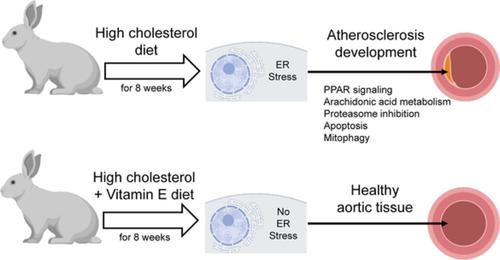当前位置:
X-MOL 学术
›
Biofactors
›
论文详情
Our official English website, www.x-mol.net, welcomes your
feedback! (Note: you will need to create a separate account there.)
High-throughput profiling reveals perturbation of endoplasmic reticulum stress-related genes in atherosclerosis induced by high-cholesterol diet and the protective role of vitamin E.
Biofactors ( IF 5.0 ) Pub Date : 2020-05-08 , DOI: 10.1002/biof.1635 Perinur Bozaykut 1, 2 , Ruchan Ekren 3 , Osman Ugur Sezerman 3 , Vadim N Gladyshev 2 , Nesrin Kartal Ozer 1
Biofactors ( IF 5.0 ) Pub Date : 2020-05-08 , DOI: 10.1002/biof.1635 Perinur Bozaykut 1, 2 , Ruchan Ekren 3 , Osman Ugur Sezerman 3 , Vadim N Gladyshev 2 , Nesrin Kartal Ozer 1
Affiliation

|
Formation of atherosclerotic plaques, called atherogenesis, is a complex process affected by genetic and environmental factors. It was proposed that endoplasmic reticulum (ER) stress is an important factor in the pathogenesis of atherosclerosis and that vitamin E affects atherosclerotic plaque formation via its antioxidant properties. Here, we investigated ER stress‐related molecular mechanisms in high‐cholesterol diet (HCD, 2%)‐induced atherosclerosis model and the role of vitamin E supplementation in it, beyond its antioxidant properties. The consequences of HCD and vitamin E supplementation were examined by determining protein levels of ER stress markers in aortic tissues. As vitamin E supplementation acts on several unfolded protein response (UPR) factors, it decreased ER stress induced by HCD. To elucidate the associated pathways, gene expression profiling was performed, revealing differentially expressed genes enriched in ER stress‐related pathways such as the proteasome and the apoptosis pathways. We further assessed the proteasomal activity impaired by HCD in the aorta and showed that vitamin E reversed it to that of control animals. Overall, the study characterized the effects of HCD and vitamin E on ER stress‐related gene expression, revealing the role of proteolytic systems during atherogenesis.
中文翻译:

高通量分析揭示了高胆固醇饮食诱导的动脉粥样硬化中内质网应激相关基因的扰动和维生素 E 的保护作用。
动脉粥样硬化斑块的形成,称为动脉粥样硬化,是一个受遗传和环境因素影响的复杂过程。有人提出内质网 (ER) 应激是动脉粥样硬化发病机制中的一个重要因素,而维生素 E 通过其抗氧化特性影响动脉粥样硬化斑块的形成。在这里,我们研究了高胆固醇饮食(HCD,2%)诱导的动脉粥样硬化模型中与内质网应激相关的分子机制,以及维生素 E 补充剂在其中的作用,超越了其抗氧化特性。通过测定主动脉组织中内质网应激标志物的蛋白质水平来检查补充 HCD 和维生素 E 的后果。由于维生素 E 补充剂作用于几种未折叠蛋白反应 (UPR) 因子,它减少了 HCD 诱导的内质网应激。为了阐明相关的途径,进行了基因表达谱分析,揭示了富含内质网应激相关通路(如蛋白酶体和细胞凋亡通路)的差异表达基因。我们进一步评估了主动脉中 HCD 受损的蛋白酶体活性,并表明维生素 E 将其逆转为对照动物的蛋白酶体活性。总体而言,该研究表征了 HCD 和维生素 E 对内质网应激相关基因表达的影响,揭示了蛋白水解系统在动脉粥样硬化形成过程中的作用。
更新日期:2020-05-08
中文翻译:

高通量分析揭示了高胆固醇饮食诱导的动脉粥样硬化中内质网应激相关基因的扰动和维生素 E 的保护作用。
动脉粥样硬化斑块的形成,称为动脉粥样硬化,是一个受遗传和环境因素影响的复杂过程。有人提出内质网 (ER) 应激是动脉粥样硬化发病机制中的一个重要因素,而维生素 E 通过其抗氧化特性影响动脉粥样硬化斑块的形成。在这里,我们研究了高胆固醇饮食(HCD,2%)诱导的动脉粥样硬化模型中与内质网应激相关的分子机制,以及维生素 E 补充剂在其中的作用,超越了其抗氧化特性。通过测定主动脉组织中内质网应激标志物的蛋白质水平来检查补充 HCD 和维生素 E 的后果。由于维生素 E 补充剂作用于几种未折叠蛋白反应 (UPR) 因子,它减少了 HCD 诱导的内质网应激。为了阐明相关的途径,进行了基因表达谱分析,揭示了富含内质网应激相关通路(如蛋白酶体和细胞凋亡通路)的差异表达基因。我们进一步评估了主动脉中 HCD 受损的蛋白酶体活性,并表明维生素 E 将其逆转为对照动物的蛋白酶体活性。总体而言,该研究表征了 HCD 和维生素 E 对内质网应激相关基因表达的影响,揭示了蛋白水解系统在动脉粥样硬化形成过程中的作用。











































 京公网安备 11010802027423号
京公网安备 11010802027423号